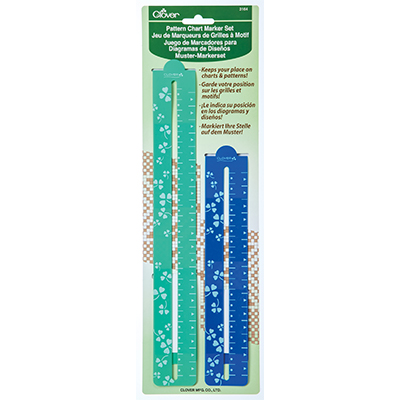topics
Pattern Chart Marker Set
Produits

What is it?
Every now and then there is a tool that is so useful, so essential that we wonder how we ever got along without it. But let’s consider, what is the real value of a tool? The value in any tool is in what it accomplishes for us. And in the case or our discussion today, that value is considerable. It’s a challenge that we all face when working from detailed or complicated lines of instruction on charts. Charts are graphic representations of knitting, embroidery or needlepoint instructions. They are an effective way to illustrate or convey those instructions in a significantly more precise and compact manner than detailed text instructions ever could. They also give us a “sneak peek” as to what we can expect to see when we work through our project. This applies to lace, color work, cable patterns, needlepoint or cross stitch. It’s always comforting to see where we are in the process. It’s also great to be able to identify problems or mistakes early. But some of those charts are extremely complicated. When we look at our chart all we see are line after line of tiny boxes and within each box is the symbol or instruction for that particular stitch. Okay, no problem. We can do that. But all of those tiny, complicated lines of instruction, how can we keep them all straight? The problem is when Macro meets Micro. Or in this case when our macro vision (sometimes referred to as mature vision) meets the micro printing of the pattern chart. How do we keep track of where we are? Remember, mistakes are frustrating, time consuming and detract from our creative experience. Well, there’s always Post-it notes or maybe paper clips or maybe just lay a ruler along the line or perhaps we could even make a copy of our chart and then high light every line as we complete it. Let’s face it, it’s a struggle with any of those. There is, however, a problem solving tool for pattern chart marking that is so useful that many consider it essential. It’s Clover’s Pattern Chart Marker.

Pattern Chart Marker Set
Art. No 3164
What does it do?
Clover’s Pattern Chart Marker is an essential tool for anyone working from instructions in a chart form. The marker is constructed of heavy duty, durable vinyl. It folds in half and is magnetic. This allows us to fold it over our pattern sheet and the magnetic function holds it securely in place until we need move on to the next line. This allows us to zero in on our current row. Markings on the tool allow us to keep track of each square along that line. This all makes even the most complicated charts easy to track. The Pattern Chart Maker is complete with two markers to accommodate any size chart or book page we may be working from.
This is one of those essential tools that make the creative process so much more enjoyable. Simply put some patterns out with the chart markers on them. Everyone will understand what it is and everyone is going to want one. Use it once and it will be a permanent part of your kit.
By Steve Butler
Retour


